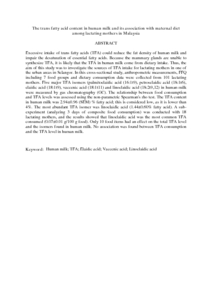Citation
Daud, Akmar Zuraini and Mohd Esa, Norhaizan and Azlan, Azrina and Chan, Yoke Mun
(2013)
The trans fatty acid content in human milk and its association with maternal diet among lactating mothers in Malaysia.
Asia Pacific Journal of Clinical Nutrition, 22 (3).
pp. 431-442.
ISSN 0964-7058; ESSN: 1440-6047
Abstract
Excessive intake of trans fatty acids (TFA) could reduce the fat density of human milk and impair the desaturation of essential fatty acids. Because the mammary glands are unable to synthesize TFA, it is likely that the TFA in human milk come from dietary intake. Thus, the aim of this study was to investigate the sources of TFA intake for lactating mothers in one of the urban areas in Selangor. In this cross-sectional study, anthropometric measurements, FFQ including 7 food groups and dietary consumption data were collected from 101 lactating mothers. Five major TFA isomers (palmitoelaidic acid (16:1t9), petroselaidic acid (18:1t6), elaidic acid (18:1t9), vaccenic acid (18:1t11) and linoelaidic acid (18:2t9,12) in human milk were measured by gas chromatography (GC). The relationship between food consumption and TFA levels was assessed using the non-parametric Spearman's rho test. The TFA content in human milk was 2.94±0.96 (SEM) % fatty acid; this is considered low, as it is lower than 4%. The most abundant TFA isomer was linoelaidic acid (1.44±0.60% fatty acid). A sub-experiment (analyzing 3 days of composite food consumption) was conducted with 18 lactating mothers, and the results showed that linoelaidic acid was the most common TFA consumed (0.07±0.01 g/100 g food). Only 10 food items had an effect on the total TFA level and the isomers found in human milk. No association was found between TFA consumption and the TFA level in human milk.
Download File
![[img]](http://psasir.upm.edu.my/29596/1.hassmallThumbnailVersion/The%20trans%20fatty%20acid%20content%20in%20human%20milk%20and%20its%20association%20with%20maternal%20diet%20among%20lactating%20mothers%20in%20Malaysia.pdf)  Preview |
|
PDF (Abstract)
The trans fatty acid content in human milk and its association with maternal diet among lactating mothers in Malaysia.pdf
Download (85kB)
| Preview
|
|
Additional Metadata
Actions (login required)
 |
View Item |

